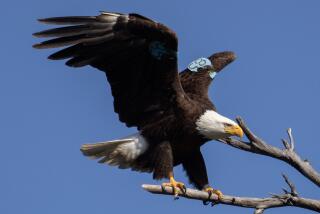Notes about your surroundings.
- Share via
Good News, Bad News--The latest developments for light-footed clapper rails include “some bright spots and some pretty bleak spots,” according to Dick Zembal, a Laguna Niguel-based U.S. Fish and Wildlife Service biologist who is the biggest champion of the endangered marsh bird.
The secretive, non-migratory clapper rail nests at just a few sites along the coast of Southern California and Baja California, with more than half the birds left in the United States concentrated in one spot--Upper Newport Bay. Decimated by steady destruction of their wetland habitat, many of the remaining birds live in small, isolated colonies that are highly vulnerable to predators and other disturbances, natural and man-made.
Among the good news this breeding season is the continued success of the Upper Newport Bay colony. This season, 131 nesting pairs were counted in the reserve, the highest in 11 years of recorded data for the site and up from 116 in 1989.
Zembal credits several factors with the increase: the high reproductive success of last season’s breeders, the relative absence of red foxes and other predators and the actual creation of new habitat. Sedimentation in the bay created a new island, which has been colonized with cordgrass (the birds’ preferred nesting material). Twelve pairs of clapper rails were discovered nesting on the island this season.
At Anaheim Bay in Seal Beach, where predation has been severe, there were 14 pairs counted this season. That’s up from a dangerous low of just six pairs and a few unmated females last season. Zembal once again credits the high nesting success of last season’s birds: When the 1989 breeding season ended, 59 birds were counted.
Other marshes where the birds are known to nest were pretty much “status quo,” Zembal said. Small colonies remain in imminent danger from a variety of catastrophes. “All it takes is the wrong kitty to be roaming the edge of the marsh,” Zembal said, “and it’s doomsday for the clapper rail.”
Meanwhile, progress on efforts to create new clapper rail habitat by reintroducing tidal access to two marshes in northern San Diego County has been frustratingly slow.
Zembal’s efforts benefit not only the clapper rail, he says; the success of this sensitive bird reflects on the general health of a salt marsh and its ability to support hundreds of bird and thousands of invertebrate species.
More to Read
Sign up for The Wild
We’ll help you find the best places to hike, bike and run, as well as the perfect silent spots for meditation and yoga.
You may occasionally receive promotional content from the Los Angeles Times.






